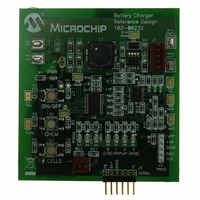MCP1631RD-MCC2 Microchip Technology, MCP1631RD-MCC2 Datasheet - Page 66

MCP1631RD-MCC2
Manufacturer Part Number
MCP1631RD-MCC2
Description
REFERENCE DESIGN MCP1631HV
Manufacturer
Microchip Technology
Datasheets
1.MCP1631VHVT-330EST.pdf
(34 pages)
2.MCP1631HV-330EST.pdf
(54 pages)
3.MCP1631RD-MCC2.pdf
(20 pages)
4.MCP1631RD-MCC2.pdf
(328 pages)
Specifications of MCP1631RD-MCC2
Main Purpose
Power Management, Battery Charger
Embedded
Yes, MCU, 8-Bit
Utilized Ic / Part
MCP1631HV, PIC16F883
Primary Attributes
1 ~ 2 Cell- Li-Ion, 1 ~ 5 Cell- NiCd/NiMH, 1 ~ 2 1W LEDs
Secondary Attributes
Status LEDs
Silicon Manufacturer
Microchip
Application Sub Type
Battery Charger
Kit Application Type
Power Management - Battery
Silicon Core Number
MCP1631HV, PIC16F883
Kit Contents
Board
Lead Free Status / RoHS Status
Lead free / RoHS Compliant
Lead Free Status / RoHS Status
Lead free / RoHS Compliant
- MCP1631VHVT-330EST PDF datasheet
- MCP1631HV-330EST PDF datasheet #2
- MCP1631RD-MCC2 PDF datasheet #3
- MCP1631RD-MCC2 PDF datasheet #4
- Current page: 66 of 328
- Download datasheet (6Mb)
PIC16F882/883/884/886/887
4.4.3
The LP, XT and HS modes support the use of quartz
crystal resonators or ceramic resonators connected to
OSC1 and OSC2 (Figure 4-3). The mode selects a low,
medium or high gain setting of the internal inverter-
amplifier to support various resonator types and speed.
LP Oscillator mode selects the lowest gain setting of the
internal inverter-amplifier. LP mode current consumption
is the least of the three modes. This mode is designed to
drive only 32.768 kHz tuning-fork type crystals (watch
crystals).
XT Oscillator mode selects the intermediate gain
setting of the internal inverter-amplifier. XT mode
current consumption is the medium of the three modes.
This mode is best suited to drive resonators with a
medium drive level specification.
HS Oscillator mode selects the highest gain setting of the
internal inverter-amplifier. HS mode current consumption
is the highest of the three modes. This mode is best
suited for resonators that require a high drive setting.
Figure 4-3 and Figure 4-4 show typical circuits for
quartz crystal and ceramic resonators, respectively.
FIGURE 4-3:
DS41291F-page 64
Note 1: A series resistor (R
C1
C2
2: The value of R
quartz crystals with low drive level.
selected (typically between 2 MΩ to 10 MΩ).
LP, XT, HS MODES
Quartz
Crystal
R
S
(1)
QUARTZ CRYSTAL
OPERATION (LP, XT OR
HS MODE)
F
varies with the Oscillator mode
OSC1/CLKIN
OSC2/CLKOUT
R
S
F (2)
PIC
) may be required for
®
MCU
Sleep
To Internal
Logic
FIGURE 4-4:
Note 1: A series resistor (R
Note 1: Quartz crystal characteristics vary according
C1
C2 Ceramic
2: The value of R
3: An additional parallel feedback resistor (R
2: Always verify oscillator performance over
3: For oscillator design assistance, reference
Resonator
ceramic resonators with low drive level.
selected (typically between 2 MΩ to 10 MΩ).
may be required for proper ceramic resonator
operation.
• AN826, “Crystal Oscillator Basics and
• AN849, “Basic PIC
• AN943, “Practical PIC
• AN949, “Making Your Oscillator Work”
to type, package and manufacturer. The
user should consult the manufacturer data
sheets for specifications and recommended
application.
the V
expected for the application.
the following Microchip Applications Notes:
Crystal Selection for rfPIC
Devices” (DS00826)
(DS00849)
Analysis and Design” (DS00943)
(DS00949)
DD
R
P (3)
R
S
and temperature range that is
(1)
CERAMIC RESONATOR
OPERATION
(XT OR HS MODE)
© 2009 Microchip Technology Inc.
F
varies with the Oscillator mode
OSC1/CLKIN
OSC2/CLKOUT
S
R
) may be required for
®
F
PIC
(2)
Oscillator Design”
®
®
Oscillator
MCU
®
and PIC
To Internal
Logic
Sleep
®
P
)
Related parts for MCP1631RD-MCC2
Image
Part Number
Description
Manufacturer
Datasheet
Request
R

Part Number:
Description:
REFERENCE DESIGN FOR MCP1631HV
Manufacturer:
Microchip Technology
Datasheet:

Part Number:
Description:
REF DES BATT CHARG OR LED DRIVER
Manufacturer:
Microchip Technology
Datasheet:

Part Number:
Description:
Manufacturer:
Microchip Technology Inc.
Datasheet:

Part Number:
Description:
Manufacturer:
Microchip Technology Inc.
Datasheet:

Part Number:
Description:
Manufacturer:
Microchip Technology Inc.
Datasheet:

Part Number:
Description:
Manufacturer:
Microchip Technology Inc.
Datasheet:

Part Number:
Description:
Manufacturer:
Microchip Technology Inc.
Datasheet:

Part Number:
Description:
Manufacturer:
Microchip Technology Inc.
Datasheet:

Part Number:
Description:
Manufacturer:
Microchip Technology Inc.
Datasheet:

Part Number:
Description:
Manufacturer:
Microchip Technology Inc.
Datasheet:










